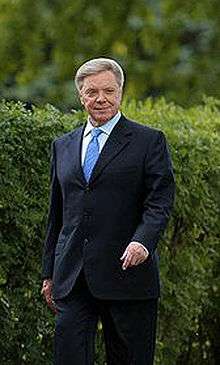Boris Gromov
| Boris Vsevolodovich Gromov | |
|---|---|
 Governor Boris Gromov | |
| Born |
7 November 1943 Saratov, Soviet Union |
| Allegiance |
|
| Service/branch | Soviet Army, Russian Ground Forces |
| Years of service | 1962-1994 |
| Rank | Colonel General |
| Commands held | 40th Army, Kiev Military District |
| Battles/wars | Soviet war in Afghanistan |
| Awards |
|
Boris Vsevolodovich Gromov (Russian: Бори́с Все́володович Гро́мов; born 7 November 1943 in Saratov, Russia) is a prominent Russian military and political figure. From 2000 to 2012, he was the Governor of Moscow Oblast.
Biography
He graduated from a Suvorov military cadet school, the Leningrad Military Commanders School and later from the Frunze Military Academy in Moscow, as well as the General Staff Academy.
During the Soviet war in Afghanistan, Gromov did three tours of duty (1980–1982, 1985–1986, 1987–1989), and was best known for the two years as the last Commander of the 40th Army in Afghanistan. Gromov was the last Soviet soldier to leave Afghanistan, crossing on foot the Friendship Bridge spanning the Amu-Daria river on 15 February 1989, the day the Soviet pullout from Afghanistan was completed. He received the highest military award – the golden star of the Hero of the Soviet Union after Operation Magistral had lifted the siege of the city of Khost in eastern Afghanistan.
After the Afghan war, he was chosen as a candidate for Vice President by the Communist Party in the Russian presidential election of 1991 (the candidate for President was former Premier Nikolai Ryzhkov). He served as First Deputy Defence Minister of the Russian Federation. In 1994 Gromov retired from the Russian Military Forces, and was soon appointed deputy Interior Minister. He was elected in 1995 to the State Duma, lower house of Russian parliament. In January 2000 he was elected governor of the Moscow region and re-elected in December 2003.
Honours and awards
- Order of Merit for the Fatherland;
- 2nd class (6 November 2003) - for outstanding contribution to strengthening Russian statehood, and socio-economic development of the region
- 3rd class
- 4th class (7 November 2008) - for outstanding contribution to the socio-economic development of the Moscow region and many years of fruitful work
- Order of Lenin
- Order of the Red Banner, twice
- Order of the Red Star
- Order for Service to the Homeland in the Armed Forces of the USSR, 3rd class
- Medal for Combat Service
- Hero of the Soviet Union
- Medal "For merits in perpetuating the memory of the fallen defenders of the Fatherland" (Russian Ministry of Defence, 2008) - for his great personal contribution to the commemoration of the fallen defenders of the Fatherland, the establishment of names of the dead and the fate of missing servicemen, displaying high moral and business qualities, diligence and intelligent initiative, to assist in the task of perpetuating the memory of the fallen defenders of the Fatherland
- Medal "For Impeccable Service" 1st, 2nd and 3rd classes
- Order of Prince Yaroslav the Wise, 5th class (Ukraine, 7 November 2003)
- Medal "10 Years of the Armed Forces of Ukraine"
- Order of Friendship of Peoples (Belarus) (22 November 2005) - for his significant contribution to the development of economic, scientific-technological and cultural ties between Belarus and Moscow Oblast of the Russian Federation
- Medal "In memory of the 10th anniversary of the withdrawal of Soviet troops from Afghanistan" (Belarus, 13 February 2003) - for his great personal contribution to the development and strengthening of cooperation between movements of Afghan War Veterans of the Republic of Belarus and the Russian Federation [56] [57]
- Medal "Fidelity" (Afghanistan, 17 November 1988)
- Order of St. Prince Vladimir Equal, 1st class (Russian Orthodox Church, 2008) - in consideration of special services for the Moscow diocese of the Russian Orthodox Church and the 65th anniversary of the birth
- Order of the Holy Prince Daniel of Moscow, 1st class
- Order of St. Sergius
- Order of Saint Blessed Grand Prince Dmitry Donskoy, 1st class
- Jubilee Medal "In Commemoration of the 100th Anniversary since the Birth of Vladimir Il'ich Lenin"
- Jubilee Medal "Twenty Years of Victory in the Great Patriotic War 1941-1945"
- Jubilee Medal "50 Years of the Armed Forces of the USSR"
- Jubilee Medal "60 Years of the Armed Forces of the USSR"
- Jubilee Medal "70 Years of the Armed Forces of the USSR"
- Order of the Red Banner (Afghanistan)
External links
- Boris Gromov, Official website of Boris Gromov (Russian)
- Official website of Moscow Oblast. Boris Gromov, Governor (Russian)
- ITN & Pro Video documentary. Wars In Peace - Afghanistan (1990). Available on Google Video
| Political offices | ||
|---|---|---|
| Preceded by Anatoliy Tyazhlov |
Governor of Moscow Oblast 2000–2012 |
Succeeded by Sergey Shoygu |